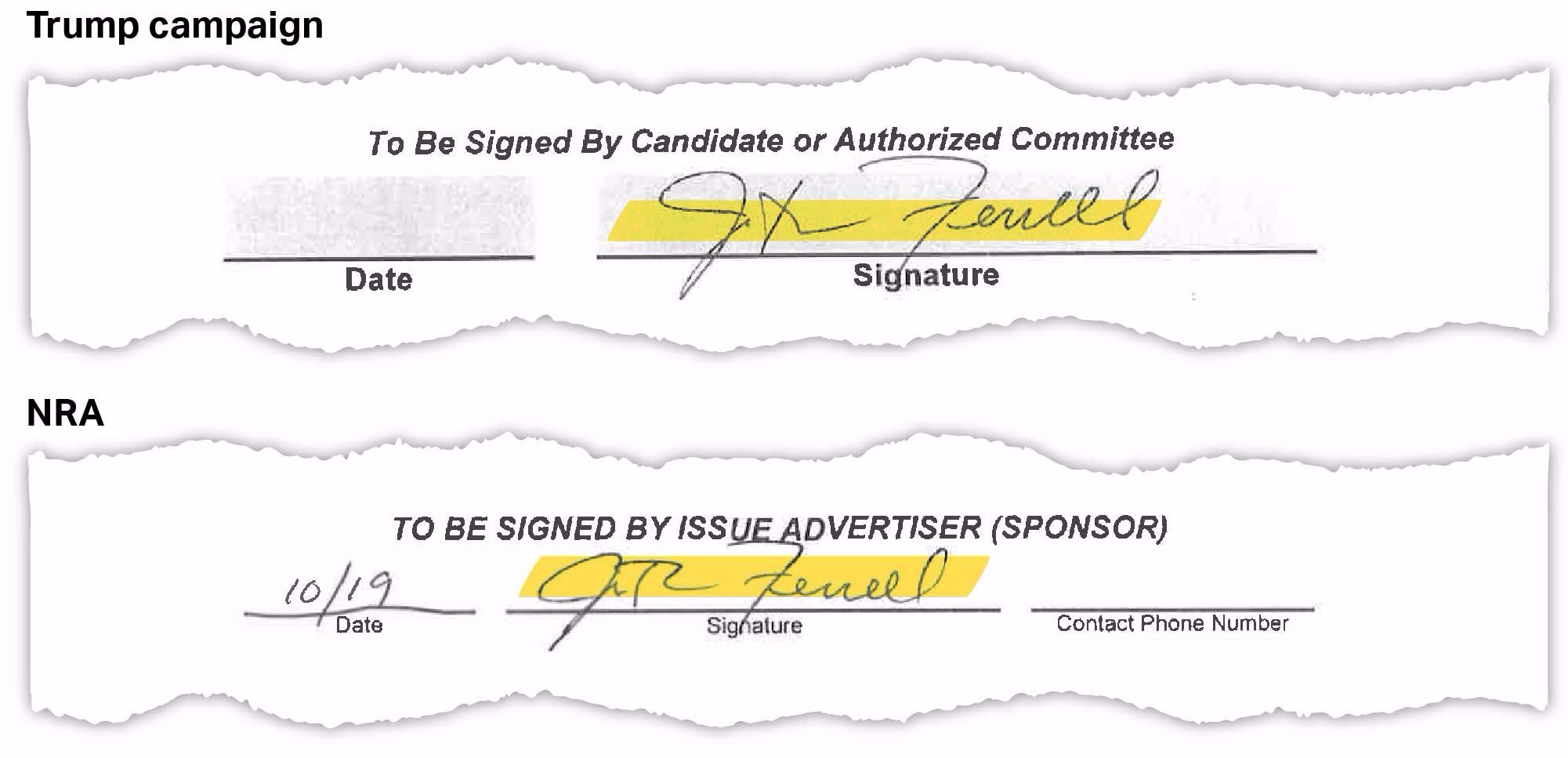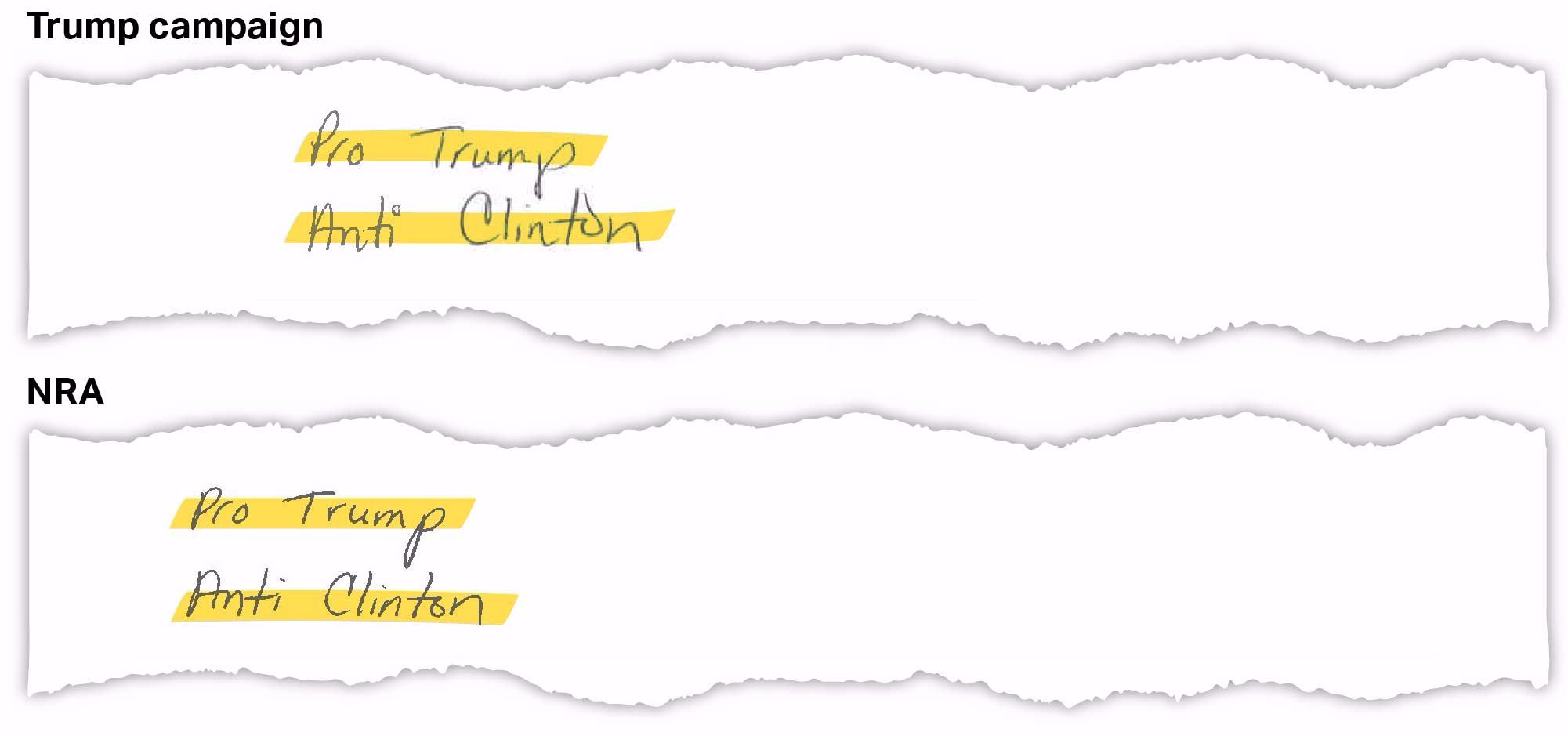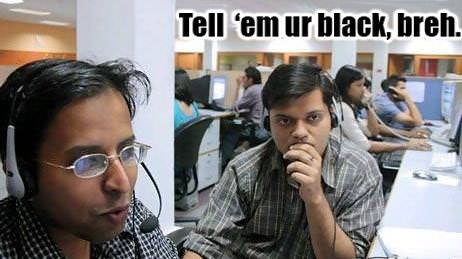PART 2:

Sources: Trump campaign contract; NRA contract / Daniel Nass
Ferrell, Kovatch, Angle, and Kowalski did not respond to requests for comment. According to their National Media bios or LinkedIn pages, all are specialists in the art of strategic media placement. Ferrell’s “efforts help [National Media] provide optimal financial stewardship of campaign media budgets.” Kovatch “has consistently bought the largest media markets around the country, building an extensive knowledge of ratings, costs and seasonal trends across all time periods and dayparts.” Angle uses his “extensive experience” to “strategically place efficient and effective media buys for our clients.” And Kowalski “acted as a liaison between media buyers and TV, radio, and cable networks,” and “researched voter demographic data to help create” advertising campaigns for, among others, “presidential” candidates and “issue-advocacy groups.”
Prior reporting has identified consulting firms as conduits for potentially illegal coordination between campaigns and outside groups. In 2013, a Center for Public Integrity and NBC News investigation turned up evidence that an AMAG media buyer purchased airtime both for a Texas congressional candidate and for an outside group that was supporting him. In July, we found that the NRA had been using an apparent shell firm called Starboard Strategic Inc. to produce ads for Senate candidates who employed a GOP consulting outfit called OnMessage Inc. The two entities, according to subsequent complaints filed to the FEC, are “functionally indistinguishable.” Starboard and OnMessage are located in the same Alexandria buildings as National Media, according to public records.
The FEC has the authority to launch investigations and seek civil penalties, but it’s unlikely that the NRA or the Trump campaign will face any official action. The FEC’s four commissioners—it is supposed to have six—have been deadlocked for years in an ideological split, making the unanimous vote required for significant investigations almost impossible to achieve. The Department of Justice is also authorized to launch investigations, but prosecutions under the Federal Election Campaign Act are uncommon. If convicted, violators can be subject to criminal fines and up to five years in prison.
Experts say the apparent coordination is the most glaring they’ve ever seen.
“It is impossible for these consultants to have established firewalls in their brains,” Brendan Fischer, the director of the Federal Reform Program at the Campaign Legal Center, said. “We have not previously seen this level of evidence undermining any claim of a firewall.”

Sources: Trump campaign contract; NRA contract / Daniel Nass
Effectively placing ads is among the most important tasks in getting a candidate elected to office. “The creative content is only part of the equation,” said Rick Wilson, a Republican media strategist. “Political advertising relies on smart media placement at every stage. Anything else and you might as well just throw your money in a bonfire.”
Campaign coordination, Wilson added, allows candidates and outside groups to “maximize their resources,” making spending far more efficient. “Modern campaigns are driven by data,” he said. “Pollsters and analytics people will give you a set of targets, and you want to address those targets as best you can, in as many markets as you can.”
Concurrent purchases by Red Eagle and AMAG appear to have been designed to provide such a higher return on spending. On September 15, 2016, for instance, Red Eagle executed an $86,000 deal for the NRA with Raycom Sports Network, a syndicator of sports programs, for slots during seven ACC college football games airing during the final weeks of the presidential race. Documents authorizing the purchase were signed by Ferrell, whose colleague Ben Angle, the senior buyer at National Media, has been a proponent of sports as a way to reach conservative audiences. “Every time we assist a Republican candidate, we advise him to advertise at sports events,” he told one journalist. “In sports, the audience is engaged, they like to see it live so they do not skip the commercials by using a recording device.”
Less than a week later, another National Media staffer authorized virtually the same purchase for Trump. Because stations are required to charge candidates the so-called “lowest unit price” for airtime (while charging independent groups the higher market rate), the deal only cost $30,000.
The purchases were mirror images of each other. In five of the games, both the NRA and Trump bought ads. When the NRA ran two spots either attacking Clinton or promoting Trump, the Trump campaign ran just one. And when the Trump campaign ran two spots, the NRA ran one. The pattern even persisted when there was no direct overlap: In the two games the Trump campaign sat out, the NRA ran two ads. And in the one game during which the NRA didn’t buy time, Trump bought two slots. Side by side, the spots aired across the country on as many as 120 stations, according to data provided by Raycom.
Angle’s name appears on Trump campaign paperwork documenting the Raycom purchase, directly above “AMAG.”
After reviewing the Raycom records, Wilson said the pattern suggests the purchases were part of a unified strategy by the NRA and the Trump campaign. “Sometimes you want to maximize the lowest unit rate on the campaign side,” he said. “But you still need more fire on the target. This is why the FEC says coordination is illegal.”
(Mother Jones and the Trace have teamed up to investigate the NRA’s finances and political activity. See more of our reporting here.)

Sources: Trump campaign contract; NRA contract / Daniel Nass
Ferrell, Kovatch, Angle, and Kowalski did not respond to requests for comment. According to their National Media bios or LinkedIn pages, all are specialists in the art of strategic media placement. Ferrell’s “efforts help [National Media] provide optimal financial stewardship of campaign media budgets.” Kovatch “has consistently bought the largest media markets around the country, building an extensive knowledge of ratings, costs and seasonal trends across all time periods and dayparts.” Angle uses his “extensive experience” to “strategically place efficient and effective media buys for our clients.” And Kowalski “acted as a liaison between media buyers and TV, radio, and cable networks,” and “researched voter demographic data to help create” advertising campaigns for, among others, “presidential” candidates and “issue-advocacy groups.”
Prior reporting has identified consulting firms as conduits for potentially illegal coordination between campaigns and outside groups. In 2013, a Center for Public Integrity and NBC News investigation turned up evidence that an AMAG media buyer purchased airtime both for a Texas congressional candidate and for an outside group that was supporting him. In July, we found that the NRA had been using an apparent shell firm called Starboard Strategic Inc. to produce ads for Senate candidates who employed a GOP consulting outfit called OnMessage Inc. The two entities, according to subsequent complaints filed to the FEC, are “functionally indistinguishable.” Starboard and OnMessage are located in the same Alexandria buildings as National Media, according to public records.
The FEC has the authority to launch investigations and seek civil penalties, but it’s unlikely that the NRA or the Trump campaign will face any official action. The FEC’s four commissioners—it is supposed to have six—have been deadlocked for years in an ideological split, making the unanimous vote required for significant investigations almost impossible to achieve. The Department of Justice is also authorized to launch investigations, but prosecutions under the Federal Election Campaign Act are uncommon. If convicted, violators can be subject to criminal fines and up to five years in prison.
Experts say the apparent coordination is the most glaring they’ve ever seen.
“It is impossible for these consultants to have established firewalls in their brains,” Brendan Fischer, the director of the Federal Reform Program at the Campaign Legal Center, said. “We have not previously seen this level of evidence undermining any claim of a firewall.”

Sources: Trump campaign contract; NRA contract / Daniel Nass
Effectively placing ads is among the most important tasks in getting a candidate elected to office. “The creative content is only part of the equation,” said Rick Wilson, a Republican media strategist. “Political advertising relies on smart media placement at every stage. Anything else and you might as well just throw your money in a bonfire.”
Campaign coordination, Wilson added, allows candidates and outside groups to “maximize their resources,” making spending far more efficient. “Modern campaigns are driven by data,” he said. “Pollsters and analytics people will give you a set of targets, and you want to address those targets as best you can, in as many markets as you can.”
Concurrent purchases by Red Eagle and AMAG appear to have been designed to provide such a higher return on spending. On September 15, 2016, for instance, Red Eagle executed an $86,000 deal for the NRA with Raycom Sports Network, a syndicator of sports programs, for slots during seven ACC college football games airing during the final weeks of the presidential race. Documents authorizing the purchase were signed by Ferrell, whose colleague Ben Angle, the senior buyer at National Media, has been a proponent of sports as a way to reach conservative audiences. “Every time we assist a Republican candidate, we advise him to advertise at sports events,” he told one journalist. “In sports, the audience is engaged, they like to see it live so they do not skip the commercials by using a recording device.”
Less than a week later, another National Media staffer authorized virtually the same purchase for Trump. Because stations are required to charge candidates the so-called “lowest unit price” for airtime (while charging independent groups the higher market rate), the deal only cost $30,000.
The purchases were mirror images of each other. In five of the games, both the NRA and Trump bought ads. When the NRA ran two spots either attacking Clinton or promoting Trump, the Trump campaign ran just one. And when the Trump campaign ran two spots, the NRA ran one. The pattern even persisted when there was no direct overlap: In the two games the Trump campaign sat out, the NRA ran two ads. And in the one game during which the NRA didn’t buy time, Trump bought two slots. Side by side, the spots aired across the country on as many as 120 stations, according to data provided by Raycom.
Angle’s name appears on Trump campaign paperwork documenting the Raycom purchase, directly above “AMAG.”
After reviewing the Raycom records, Wilson said the pattern suggests the purchases were part of a unified strategy by the NRA and the Trump campaign. “Sometimes you want to maximize the lowest unit rate on the campaign side,” he said. “But you still need more fire on the target. This is why the FEC says coordination is illegal.”
(Mother Jones and the Trace have teamed up to investigate the NRA’s finances and political activity. See more of our reporting here.)
Last edited:
 and they both said he's probably the quietest prosecutor in history
and they both said he's probably the quietest prosecutor in history 







